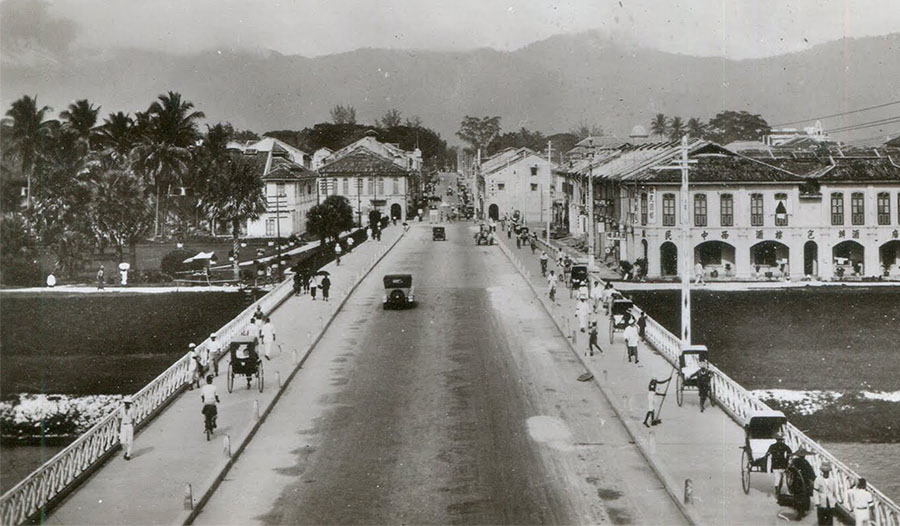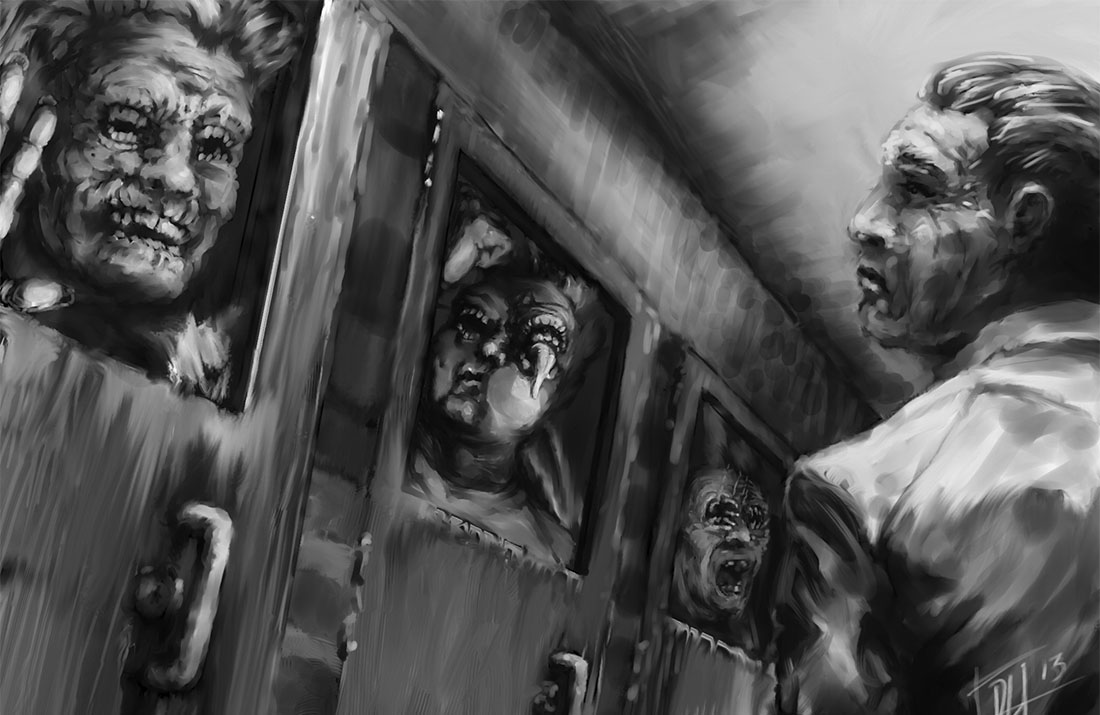Go to Eternal Lies: The Alexandrian Remix

Campaign Notes – Diorama – Props Packet
Bangkok is probably the most complicated locale in the Eternal Lies campaign: There are a lot of moving pieces for the GM to juggle and the investigation to unravel the Bangkok cult is difficult and dangerous for the players. This is probably even more true in the Alexandrian Remix because I ended up transforming the city into a second hub for the campaign.
From a structural standpoint, I ended up adding enough material to Bangkok that it now functionally “doubles” for Los Angeles. In the original campaign, the PCs hit Los Angeles and gain clues pointing them to all the other locations. In the remix, you could skip Los Angeles entirely and accomplish the same thing in Bangkok. Clues from Bangkok point to Malta, Mexico City, Los Angeles, and Ethiopia. (There’s even a subtle clue that might get the PCs to the Yucatan.)
But Bangkok is also a second hub thematically: Savitree stands largely independent from Trammel’s network of Nectar dealers, and where Trammel eagerly rushes forward to embrace the strange power behind the Mouths, Savitree is paranoically cautious in her approach to it. And the cult leaders in Malta and Mexico City are caught between these two centers of power. (Which you’ll see reflected in the differences between the correspondence they exchange with Trammel and the correspondence they exchange with Savitree.)
INVESTIGATION ORGANIZATION
The other thing that I think makes Bangkok a difficult location to run out-of-the-book is that the material has been primarily organized by the goal the PCs are currently pursuing instead of the thing they are doing. This leaves the GM flipping back and forth through the scenario trying to find all the information relating to the thing that’s happening right now.
A simple example of this is the character of Siripong: He’s encountered in the scene “Shadowing Lowman” and about half of the information he can impart to the PCs is included there (because it relates to Lowman). But then you have to jump ahead several pages to get the other half of the information he can provide (because it relates to finding the fights in “I’m Looking for the Fights”).
For my remix notes, I’ve tried to group information together tactically. Hopefully I’ve managed to do this, largely through the expedient of splitting locations from NPCs to keep the information less cluttered.
MAPS
The other thing that makes Bangkok a difficult location to run is the lack of maps. This is a point where I and the authors of Eternal Lies have strong philosophical differences. They repeatedly and explicitly lay out their opposition to the idea of using maps as a reference tool:
Maps of the Bangkok cult’s sewer stronghold are not provided in order to eliminate your temptation to turn an exploration of the sewers into a traditional RPG dungeon crawl.
(…) You should never find yourself saying things like: “You go another 30 feet and find a doorway on your left. You can see prison cells through the door.”
Instead, they want you to say things like this:
“You slink down a curving, flooded passageway awash in feces. Through a rough doorway that looks like it was hacked from an older tunnel with a pickaxe, you spy a rough iron grate with a hinged door in it. Through the grate you see what look like they might be cells, but the light in there is thrown by a few meager scattered candles, so God knows whether you’re right or what else might be waiting in there.”
Whereas I wouldn’t recommend saying either one of those: The first is obviously bland pap, but both descriptions are inadequate by virtue of failing to give a complete vision of the situation necessary for the players to make decisions as if they were their characters. (Most notably: Does the passageway they’re currently in continue or is the door their only option for moving forward?)
The authors’ primary point is this: “Describe the area as the Investigators experience it, not (necessarily) as it actually is.”
Which is good advice. But, to be blunt, it’s how you should be running your dungeon crawls.
And, more importantly, has nothing to do with the utility provided by maps. This GMing advice is a little like claiming that you shouldn’t give NPCs names because then bad GMs won’t describe how they look.
In any case, the primary effect of this strident declamation that they don’t know how to run a dungeon crawl is that pages and pages of largely unorganized text are spent trying to communicate information that could be instantly conveyed to the GM in a single glance via a map. Which is why you’ll find a whole bunch of maps in the campaign notes. And if looking at a map suddenly makes you want to break out a Chessex map and miniatures and convert your characters to D&D so that you can start throwing fireballs around… well, don’t do that. Bad boy. No cookie.
SCENARIO FLOW
The other thing you’ll note in reading through the Bangkok chapter of Eternal Lies is that the authors feel strongly that Savitree’s mansion has to be the big finale for the chapter. For example, in “Finding the Island” they write:
You should avoid staging this scene until after the Investigators have had the opportunity to infiltrate and investigate the death-fights. Otherwise, it’s possible that they’ll miss the valuable information that they can learn there (and, of course, that they’ll avoid the grim circumstances and experience you can inflict on them in that constellation of scene).
The concern seems to be that the PCs will short cut to Savitree, take her out, and then leave because they’ve finished Bangkok. But this argument ends up being circular: They’ll have finished  Bangkok after dealing with Savitree because dealing with Savitree is the last thing they’ll do in Bangkok, so you need to make sure that Savitree is the last thing they’ll do in Bangkok so that they’ll leave after dealing with her.
Bangkok after dealing with Savitree because dealing with Savitree is the last thing they’ll do in Bangkok, so you need to make sure that Savitree is the last thing they’ll do in Bangkok so that they’ll leave after dealing with her.
In running the locale, I think you’ll find it more useful to think of it roughly in terms of a triangle: One corner of the triangle is the initial investigation in Bangkok as they follow up on their initial leads. Another corner is Ko Kruk Island (where Savitree is). And the third corner is the arena where the fights are held.
If they go to the fights first, then they’ll learn that there’s a shadowy mastermind behind the Bangkok cult and they’ll have to deal with her. Taking out the shadowy mastermind is the conclusion of Bangkok because it’s the pay-off for their entire investigation (having crawled up through the cult hierarchy).
If they go to Ko Kruk Island first, then they’ll take out Savitree only to learn of the horrible things that her cult is doing in Bangkok. Taking out the Major Mouth underneath the arena of death will be the conclusion of Bangkok because it’s a huge action scene ripped straight out of pulp fiction culminating (most likely) in a giant explosion.
If the PCs take out the Major Mouth but don’t deal with Savitree, she’ll summon another one and the assassins she sends after them will make it clear that they’ve left unfinished business behind them.
If the PCs take out Savitree but not the Major Mouth, then Savitree’s caution will be thrown to the wind and violent Bangkok nectar will begin flowing out of Siam. As the PCs continue their investigation, the dangerous rise of Bangkok nectar will make it clear that they’ve only made things worse.
This is one of the big tricks with node-based scenario design: Instead of trying to predetermine what the “big conclusion” is in a given scenario, you instead want to look at the box of tools the scenario gives you and figure out which tools you can use to provide the conclusion that the players create for themselves.
PROP NOTES
Savitree’s Research: The props file for this location does NOT include Savitree’s Research. Those are being presented separately (see link below).
Scrap of Correspondence with Donovan: This prop has been designed with the intention of actually burning away the edges of the paper you print it on. For best effect, don’t be afraid of burning away some of the words (or parts of words) along the edges. The only essential element of the clue is “Montgomery Donovan – Valetta, Malta”. (Although keeping the word “sacrifice” is also thematically a good idea.)


 First, Shakespeare was writing in a well-established “taming your wife with physically abusive comedy” genre that was very popular in Elizabethan theater. So, to some extent, you’ve basically got the script from one episode of Friends and you’re trying to produce it 400 years from now after everyone has forgotten what a sitcom is.
First, Shakespeare was writing in a well-established “taming your wife with physically abusive comedy” genre that was very popular in Elizabethan theater. So, to some extent, you’ve basically got the script from one episode of Friends and you’re trying to produce it 400 years from now after everyone has forgotten what a sitcom is.











